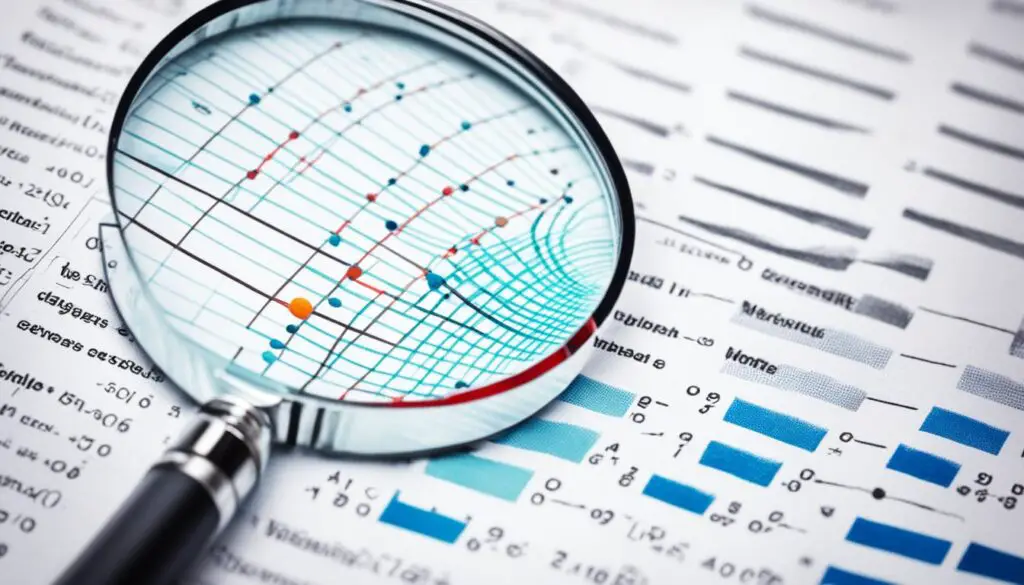Welcome to our study on correlational research designs! We’ll explore the world of studying relationships between variables. This is done without directly changing or controlling them. Such research gives us insights into how strong or weak the connections are, and if they’re good or bad.
It’s key to know that just because two things are related doesn’t mean one causes the other. Correlational research finds interesting links but doesn’t prove cause and effect. Yet, it’s a powerful tool for understanding complex relationships in the real world. It’s also great for predicting outcomes and testing new ways to measure things.
Correlational studies use different ways to collect data such as surveys and watching people in their natural settings. Surveys include asking questions through questionnaires, letting researchers look at specific variables. Watching behaviors in a natural setting helps researchers understand things in a real-world setting. Analyzing data that already exists, from records or past studies, is also a method.
After collecting data, comes the analysis. Researchers use correlation and regression to understand the data better. Correlation helps measure how strong the link is between variables. Regression predicts how changes in one thing affect another.
It’s important to see the good and bad of correlational research compared to experiments. Over this article, we will look at the pros and cons in more detail. So, keep reading!

Key Takeaways:
- Correlational research looks at relationships between variables without changing them.
- Correlation doesn’t mean one variable causes the other. They’re different things.
- These studies are great for understanding complex relationships, predicting, and trying out new measurements.
- Methods include surveys and watching behaviors, plus analyzing old data.
- Correlation and regression help researchers understand how variables relate to each other.
When to Use Correlational Research
Correlational research is key for understanding links between variables without proving cause-and-effect. It’s different from experimental research but is useful for exploring real-world issues and creating theories.
Let’s say we want to see if bible courses help students do better in school. A direct experiment may not be possible. Yet, correlational research can show if there’s a link between taking bible courses and improved grades. It helps give clues to the relationship without assuming one causes the other.
It also helps check if new tools for measuring things are good. Researchers look at how different measurements are related. If they match well, the tool likely works right.
“Correlational research offers valuable insights into non-causal relationships and helps researchers understand complex real-world phenomena.”
Exploring Complex Real-World Relationships
Correlational research is great for looking at relationships we can’t control, like the effect of bible courses on someone’s morals. It allows for studying complex topics without adding unwanted influences.
Surveys are excellent for this type of study. They let researchers explore the link between taking bible courses and acting more morally.
Developing Theories and Hypotheses
It also helps form ideas about how things might be linked. For example, studying bible courses and values might suggest that religious teachings shape our values.
These early ideas can help plan more studies. Over time, they let researchers dive deeper into the cause and effect.
Testing Measurement Tools
Correlational research is also about checking if our tools to measure things are any good. For example, researchers might compare how much people say they are religious with a religiosity scale.
If these two ways to measure religiosity are strongly related, we can trust the scale more. So, we know it’s actually measuring what it’s supposed to.

| Advantages of Correlational Research | Limitations of Correlational Research |
|---|---|
|
|
How to Collect and Analyze Correlational Data
To gather correlational data, use methods like surveys, natural observation, and look at existing data. Surveys ask questions to measure different variables. They can be done in many ways, like online, by mail, or in person. This way, researchers can learn a lot from a large group of people. They see how different things relate to each other.
Naturalistic observation means watching and taking notes on behavior in its natural setting. This could be in a park or someone’s home. Through this, researchers can learn how things truly happen and look for patterns in what they see. But remember, looking at this data can take a lot of time. And sometimes, the observer’s own ideas can affect what they record.
You can also use data that already exists, like from official records or past studies. This is called secondary data. It’s helpful because it saves time and money. Plus, it allows you to look at many different factors and groups of people. After collecting data, you can use correlation or regression to study it. Correlation shows how strongly things are connected, and in what way. Regression helps us understand how a change in one thing might affect another. But just because two things seem to be related, it doesn’t mean one causes the other. To prove cause and effect, more research is needed.
FAQ
What is correlational research?
Correlational research looks at how variables relate without changing them. It shows if the link between variables is strong or weak. However, it doesn’t prove one variable causes the other.
When is correlational research ideal?
It’s perfect for studying non-causal links between things. Especially when we want to see how things are connected without proving one causes the other. This method is great for predicting, and understanding complex relationships.
How can correlational data be collected?
We collect correlational data with surveys, observations, and using existing data. Surveys use questions to understand the relationship between variables. Observations see how variables act in real settings. And secondary data uses info others collected for various reasons.
How is correlational data analyzed?
Analyzing correlational data involves tools like correlation or regression. Correlation checks how strong and what direction the link is between variables. Regression helps make predictions about how one variable changes with another.
What are the limitations of correlational research?
There are limits to correlational research, like not proving cause and effect directly. Also, analyzing data can take time and be influenced by personal bias. It often means we need more studies to confirm and truly understand the relationships between variables.








